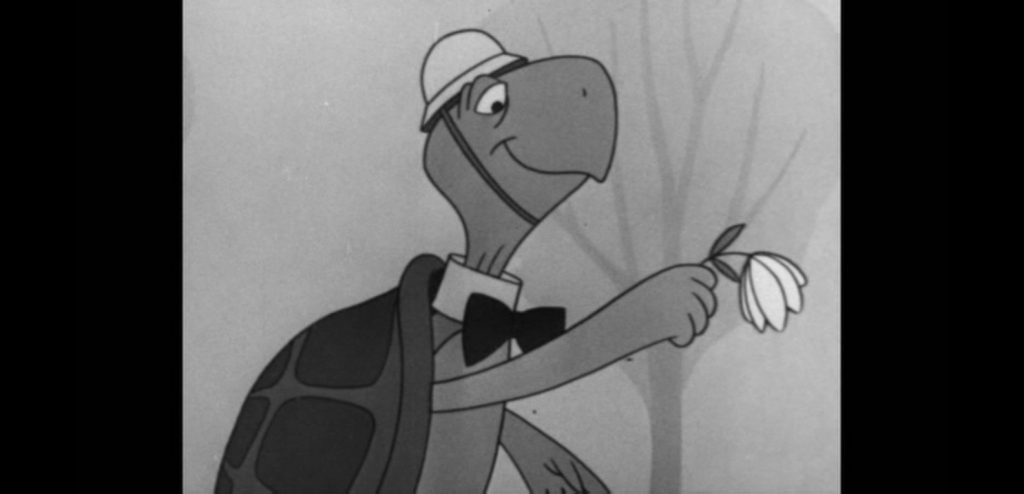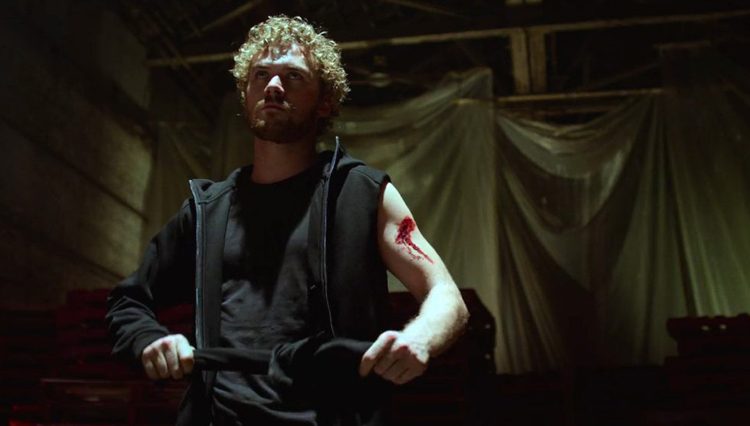“in this early and troubled stage of the atomic age, our very lives may depend on our always being alert.”

It is the ultimate ‘found footage’ absurdist documentary. Masterfully assembled from 1950s government propaganda films, newsreels, ads, and archival photos; with the exception of occasional subtitles for context, The Atomic Café presents this footage without any new narration, commentary, or interpretation. The original audio of the material with occasional period music forms its own narrative flow as it seamlessly streams from one of these ephemeral films to another showing America’s fascination and fear of the atomic bomb.
Although you’d think the material would be a dry presentation, The Atomic Café remains one of the most fascinating films I’ve ever seen. In a way, it prefigures the modern ability of a YouTube algorithm feeding you one related video after another. I first experienced it on a chance home video rental when we were three years from the original cold war with the Soviet Union coming to an end, although we had no way of knowing this at the time.
Filmmakers Kevin Rafferty, Jayne Loader, and Pierce Rafferty (all children of the 50s) originally brought us The Atomic Café in 1982 in a virtually non-existent limited domestic theatrical run. Siskel & Ebert reviewed it along with The Thing and Megaforce on At The Movies and both gave it a ‘yes’ vote. (They had not yet implemented the ‘thumbs up’ system.) But it wasn’t until after its March 1986 release on home video where Café really found an audience and became a cult classic.
The pieces of footage are at times hilarious, and at times horrifying. Footage from the Trinity test is shown, followed by a matter of fact narration of the Enola Gay’s world-changing bombing run. A giddy President Truman is shown in what seems like an outtake immediately before he becomes more somber and announces the atom bomb drop on Japan. Footage of Japanese survivors is then bluntly shown. As World War II ends and the US pressed forward with atomic testing, the film directs attention to Bikini Atoll.
Happy natives are shown smiling and agreeing to vacate their island paradise to help America and please God, perhaps partially convinced by Pepsi, Spam, and other modern wonders. They were “well pleased that the Yanks are going to add a little variety to their lives.” (The 1987 National Geographic documentary Nuclear Exiles covered the real, tragic loss to the Bikinians and other Pacific Islanders.) Some anti-communism propaganda is followed by the praise of our amazing new shopping malls with ‘free parking for all the cars that we capitalists seem to acquire.’

“It’s not safe to hope for the best without preparing for the worst. Our object is not aggression. We need not become militaristic. But we must keep our Army, our Navy, our Air Force at ready strength. We must back up our team for security!”
We then enter the era of the 1950s cold war: Korea, McCarthyism, the Rosenbergs, Eisenhower, television…along with the everyday fear that the bomb would be dropped on the United States and interrupt our otherwise idyllic 50s suburban, consumerist life of TV dinners and Reddi Whip. You’ve likely seen the Duck and Cover school training film, earnestly convincing children they could survive the atomic bomb blast if only they ducked under their desks, entered a fallout shelter, or covered themselves with any available materials.


“You know how bad sunburn can feel. The atomic bomb flash can burn you worse than a terrible sunburn. Even a newspaper can help protect you against the atomic blast!”
US testing in the Pacific catches Japanese fishing boat Daigo Fukuryū Maru unawares and 23 men, as well as their catch, are contaminated by the fallout. With this fish already sold to market, footage juxtaposes mass burials of just-caught fish in Japan with enthusiastic Americans on the West Coast testing tuna and imported tea with Geiger counters before giving such products the a-ok! (When science is on the march, nothing can stand in its way!)
An Army chaplain reassures his men stationed near one of the over 1000 atomic tests that were conducted they are perfectly safe and the blast “is a wonderful sight to behold.” (From 1946 to 1992, the U.S. government conducted more than 1,000 nuclear tests, during which unwitting troops were exposed to vast amounts of ionizing radiation. For protection, they wore utility jackets, helmets, and gas masks. They were told to cover their face with their arms.)

“Ladies and gentlemen of St. George, Utah: Word has just been received from the Atomic Energy Commission that due to a change in wind direction, the residue from this morning’s atomic detonation is drifting in the direction of St. George. It is suggested that everyone remain indoors for one hour. There is no danger. This is simply a routine Atomic Energy Commission safety procedure. Parents need not be alarmed about children at school. No recesses outdoors will be permitted.”
Films continue that reassured Americans how unsound it was to worry about the aftereffects of atomic destruction, we just needed a little preparation. Fallout shelter paranoia became all the rage and school home economics classes taught young women how to stock one and prepare meals from the prepper stockpile. The US had entered the Civil Defense era.

“Be sure to include tranquilizers to ease the strain and monotony of life in a fallout shelter. A bottle of 100 should be sufficient for a family of four. Tranquilizers are not a narcotic, and are not habit-forming.”
The amount of research, film viewing, locating materials, and editing involved in this project seems mind-boggling. The film took five years to make and the ratio of hours of material viewed to that used “was maybe 10,000 to one” according to producer-director Pierce Rafferty. Jayne Loader has referred to Cafe as “compilation verite” when describing the style of the film. It has been screened at numerous film festivals and specialty cinemas and has been used in classrooms across the country. When watching Cafe today, it is quite easy to see…comparisons to modern issues, and as Forrest Gump said “that’s all I have to say about that.”
Café has influenced modern pop culture and The Duck and Cover film which reassured children with Bert the Turtle likely re-entered public consciousness as a result. Filmmaker Michael Moore also states Cafe inspired him. “This is the movie that told me that a documentary about a deadly serious subject could be very funny. Then I asked the people who made it to teach me how to do it. They did. That movie became my first – Roger & Me (1989).” Moore went on to produce the TV series TV Nation, which was also clearly influenced by Café.

The Atomic Café was sort of forgotten for a time, then received a 2002 DVD release and interest in the film was rekindled. It was named to the National Film Registry in 2016. In 2018, a 4K restoration of the film was done by IndieCollect, funded by the National Film Preservation Board. The Kino Lorber Blu-ray release of this restoration offers exceptional sound quality as well as a dynamite amount of extra materials:
-A selection of government propaganda films courtesy of the Prelinger archives; which include “Operation Crossroads” (26:43), “Self-Preservation in an Atomic Bomb Attack” (17:43), “Atomic Alert” (10:34), “Duck and Cover” (9:12), “Survival Under Atomic Attack” (8:47), “A is for Atom” (14:42), “The House in the Middle” (12:03), “About Fallout” (23:33), “Atomic Energy as a Force for Good” (27:31), “Operation Cue” (15:11), and “The Day Called X” (28:26).
-The “Filmwax Radio Interview” (27:13) is an August 2018 reunion with moviemakers Kevin and Pierce Rafferty and Jayne Loader, who discuss the restoration of The Atomic Café. The Filmwax host has a habit of interrupting his guests, but decent information is shared concerning the early stages of production, with a plan to create the documentary dating back to 1976. Years of research ensued, with the trio practically living at the National Archive as they examined propaganda offerings. Some talk of the picture’s initial theatrical release is shared, highlighting box office success and a promotional tour that brought the directors on talk shows, including a David Letterman appearance. A modern appreciation of “The Atomic Café” is presented, and the movie’s induction into the Library of Congress Film Archives collection is marveled over, representing newfound life for the endeavor.

-“Public Shelter” is an ill-fated 1995 CD-ROM project about the Atomic Age from Loader, who provides the following sound clips: “Dwight D. Eisenhower” (14:11), “Nevada Interviews” (5:12), “Second Nevada Interview” (17:11), “Richard Nixon” (28:11), and “Subversive Activities” (13:44).
For those that prefer streaming, The Atomic Café is currently available on the Amazon Video, Google/YouTube, and Fandango platforms.
Café looked back at the world as it was thirty years prior to its production. As a worldwide pandemic and social/political issues that dominate the daily conversation trigger extremism, bringing out the worst and hopefully the best in humanity, there may be some 260 million hours of video footage uploaded to YouTube alone in 2020 for posterity. One only hopes that in thirty years, humans will be around to look back on our time with the same humor and horror.
Socially Distant Cinema is a column that will regularly point you to content from the 70s/80s currently available on various platforms that may bring you some entertainment during these periods of physical distancing...and beyond.



